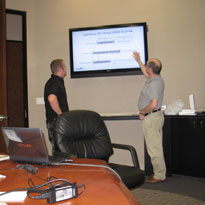IEEE WCET Exam: RF Propagation, Analysis, Design
- Course:IEEE WCET Exam: RF Propagation, Analysis, Design
- Course ID:WCET1 Duration:4 days Where: Your Office (7+ Persons)
- Download Course Description (PDF)
Available as a private, customized course for your group at your offices or ours and in some cases as a WebLive(TM) class.
Course Outline
Introduction to Wireless Technologies
- A Brief History of Wireless Communications
- The Continuing Evolution of Wireless Technologies
- Overview of Modern Wireless Technologies
Radio Wave Characteristics
- The Electro-magnetic Spectrum
- Propagation Modes of Radio Waves
- Radio Spectrum: Licensed and License Exempt
Calculator Exercise: Wavelength/frequency conversion
Fundamental Radio Concepts
- Basics of Information Transfer for Radio
- Working with Decibels: Gains, Losses, Power Levels
- Basic Radio Components
- Wireless Impairments: Internal Noise and Distortion
Calculator Exercises:
- Using decibels: Powers levels, gains and adding ratios
- Amplifier back-off vs. efficiency
- Determining the thermal noise seen by an antenna
- Receiver noise contribution; Noise Figure
Digital Modulation and Error Correction Techniques
- Analog and Digital Modulation
- Getting More Bits per Baud
- Error Correction Techniques
Calculator Exercises:
- Determining bit rate of a channel
- Determining theoretical symbol error rate
Physical Layers and Multiple Access Techniques
- Basic Access Techniques
- OFDM and OFDMA
- Spread Spectrum and CDMA
Spreadsheet Simulations:
- OFDM and Orthogonality
- CDMA and Processing Gain
Basics of Antennas and Antenna Systems
- E-M Field Radiation: Intentional and Unintentional
- Basic Antenna Types and Uses
- Basic Antenna Characteristics
- Antenna Field Regions
- Care and Feeding of Antennas
- Antenna Diversity Techniques
- Advanced Antenna Systems
Exercises and Simulations:
- Determining aperture antenna gain
- Antenna pattern evaluation: Beam-width and front-to-back ratio
- Determining antenna reactive near field
- Determining antenna radiative near field
- Converting between VSWR and reflection coefficient
- Comparing % reflected power and return loss measurements
- Phase combining simulation
Link Budget Analysis Techniques
- Noise and Noise Sources
- Link Budget Considerations
- Budgeting the Radio Link
- Determining System Reliability
Exercises:
- Determining System Gain and MAPL
- Performing simple RF power budget
- Converting gain and NFdb to linear ratios
- Performing Cascade analysis of a terrestrial receive system
- Converting NFdb to Noise Temperature
- Performing Cascade analysis of a satellite receive system
- Performing LOS link budget using manuf. equip. specifications
- Determine LOS and NLOS margin based on service objectives
Line-of-Sight Radio Propagation
- Defining Line-of-Sight
- Line-of-Sight Path Loss Analysis
Exercises:
- Determining LOS radio horizon
- Determining Fresnel zone clearance
- Performing a Free-space path loss analysis
- Determining link reliability based on rain fade margin
The Non-Line-of-Sight Propagation Environment
- Non-Line-of-Sight Propagation Mechanisms
- Impairments due to Time Dispersal
- Modeling Propagation Loss in a NLOS Environment
Exercises:
- Estimating diffraction gain for obstacle in radio path
- Determining the coherence bandwidth of a given environment
- Estimating the RMS Delay Spread of an open area
- Determining the coherence time for a given Doppler spread
- Estimating NLOS path loss using the Log Distance formula
- Compare expected loss for several models in a given environment
Course in a Nutshell
This is one of a pair of courses tied to the IEEE WCET Examination and intended for those who wish to use the WCET curriculum as a guide for their professional development. While not specifically offered as certification prep course, it will help you review and practice some of the major topics covered by the exam.
Covered are such RF (physical layer) topics as: The basics of radio system design and analysis, addressing operating frequency, available spectrum, channel bandwidth, modulation schemes, radio access techniques, basic and advanced antenna systems, using equipment specifications in link budget analysis, and performing path loss analysis based on the type of propagation environment and signal distortions caused by time displacement of radio signals in non-line-of-sight environments.
Taught as an intensive workshop, the course relies heavily on instructor/class interaction, simulations and exercises that aid the student to develop an intuitive understanding of both the theoretical concepts and their practical application. To be able to participate in the hands-on activities, a scientific calculator and laptop for running Excel spreadsheets are required.
Customize It!
The course can be customized to satisfy specific knowledge areas relative to job performance or other customer goals. We can adjust the topics and level of details to suit your audience, whether engineers, technician or managerial personnel. The course can also be extended to five days to include more discussion and practice.
Learn How To
- Perform link budget analysis for Line-of-Sight (LOS) and Non-Line-of Sight (NLOS) deployments
- Determine expected bit rate based on bandwidth, filter roll-off, Modulation/FEC
- Perform detailed cascade analysis of system components to determine system Noise Figure
- Perform path loss analysis for NLOS and LOS systems, based on distance, operating frequency, path impairments and equipment performance
- Select the proper antenna for a system based on antenna gain, radiation pattern, bandwidth, VSWR and other key performance parameters.
- Evaluate new technologies such as MIMO, Adaptive Arrays and S-OFDMA based on link performance enhancements and limitations.
Aimed At
Wireless telecommunications professionals and managers, consultants, engineers, and others involved in designing, implementing, or maintaining mobile and fixed radio systems and those who would like to review and clarify certain topics included in the IEEE WCET curriculum.
Prerequisites
A BSEE degree or equivalent knowledge/experience.
- RF Propagation, Fading, Link Budget Analysis
- Antennas
- RF Systems
- RF Optimization: GSM, GPRS, EDGE, UMTS, CDMA, 1xRTT, EVDO
- Traffic Engineering
- Traffic Engineering for 3G
- Traffic Engineering – Voice/Data
- Microwave & Fixed LOS Link Design
- TETRA
- HF Communications
- Satellite Communications: Commercial, Military
- WIMAX & Mobile WiMAX

